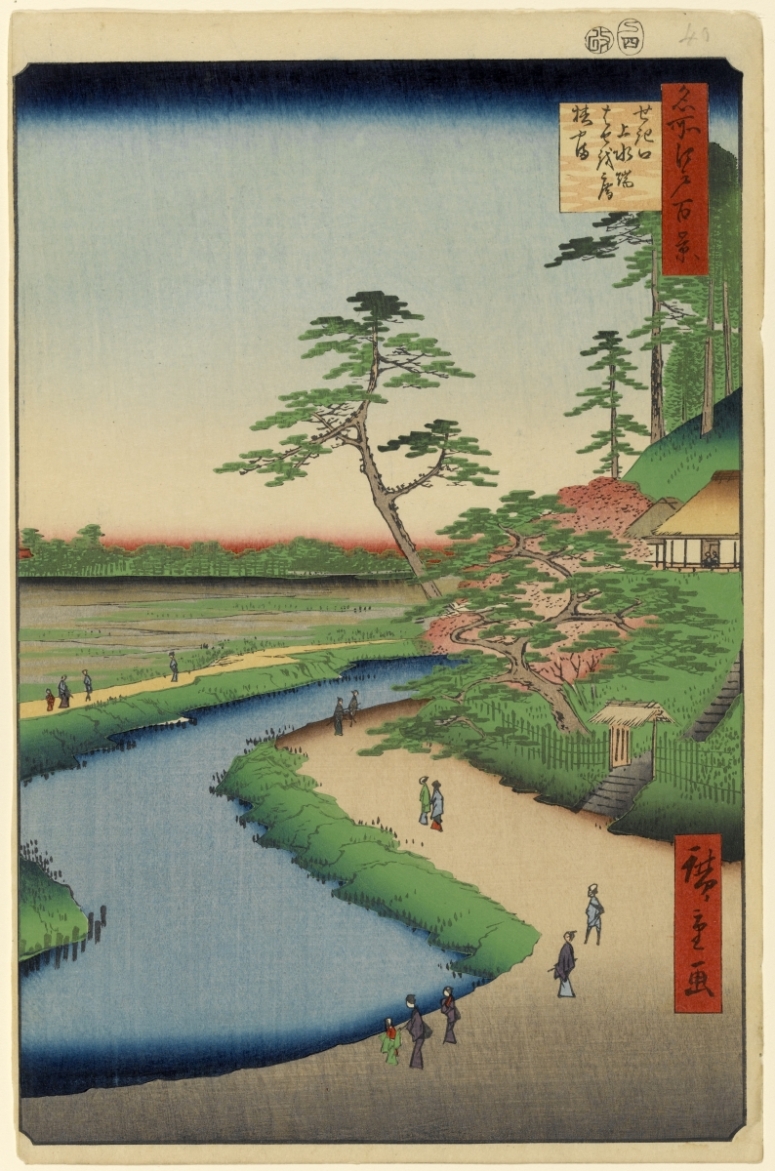One of my first impressions on reading Bashō’s text was its conciseness. As the haiku form distils a thought or impression into seventeen syllables, so the poet’s account of his journey is often condensed into only a few lines of text for each staging-post of his journey; this is not an author who likes to indulge in pages of purple prose! Sometimes the text is so compressed and contains so many layers of allusions that it is difficult for us, separated as we are by language, culture and over three hundred years, to understand its meaning. A typical example of this is the very first haiku of the book, written by Bashō to mark the selling of his house as he sets off on his journey (this example is discussed by Keene in the introduction to his translation):
草の戸も住替る代ぞひなの家(くさのともすみかわるよぞひなのいえ)
kusa no to mo
sumikawaru yo zo
hina no ie
A literal translation would be something like:
Grass door, too
change/take over dwelling
dolls’ house
which would leave the average Western reader bemused and, if they are susceptible to the power of stereotypes, muttering something to themselves about the ‘inscrutable Japanese’! The first character represents grass or any of a number of other plants (c.f. “the grass of the field”, Matt 6:30) and the third character, in addition to meaning ‘door’, is used to represent ‘house’ (“next door”), so in this line Bashō is talking about his simple home. One of the difficulties in translating from Japanese to English is that in Japanese, any parts of a sentence that are not necessary for understanding the meaning because they can be inferred by context – including the subject of the sentence – can be omitted. The second line in the poem above does not specify who is changing his dwelling, but this does not matter; most changes of dwelling involve one person or family moving out and another moving in, and the line allows us to see this from both perspectives simultaneously. The final line implies that, unlike the bachelor Bashō, the new owner has at least one daughter, who is celebrated by putting out dolls on Hinamatsuri/Girls’ Day (celebrated on 3rd March in the modern calendar).

『せき口上水端はせを庵椿やま』 (Basho’s Hermitage and Camellia Hill on the Kanda Aqueduct at Sekiguchi) by Utagawa Hiroshige (歌川広重) (1797–1858)
A second impression is that Bashō’s lack of flowery descriptions is not the result of a lack of emotion or an attempt at a ‘stiff upper lip’. He describes his desire to travel in emotional and romantic terms:
… I too for years have been stirred by the sight of a solitary cloud drifting with the wind to ceaseless thoughts of roaming. (trans.: Keene)
but when he does set off on his journey, he is overcome with emotion at the thought of leaving his friends:
I stood at the crossways of parting in this dreamlike existence and wept tears of farewell. (trans.: Keene)
Throughout his account, Bashō describes the legends associated with the places he visits and quotes old poems; he appears to have a romantic, nostalgic attraction to the journey, even, at one point, talking of ‘men of old [who] died on the road’ as if this were a romantic and desirable thing. He is constantly aware of his frailty and appears not to be a particularly physically strong man, talking of his ‘scrawny shoulders’ and sometimes describing how he suffered on the road. The purpose of his journey does not seem to have been to demonstrate is capability of performing the physical feat, but instead seems to have been romantic or spiritual. He clearly believed, however, that there was something to be gained by physically being in a place, rather than simply reading about it from the comfort of his grass-roofed house.
The practical details of travel in the Japan of three hundred years ago are also interesting. Bashō describes his preparations for the journey, which involve patching his trousers, putting a new cord onto his hat and having Moxibustion performed on his legs to strengthen them. The contents of his pack consisted of his raincoat, pen and ink, yukata and ‘a set of paper clothes to protect me from the cold of night’. In common with everyone else who has travelled around Japan, he was in addition given parting gifts. He comments that ‘… I could not very well refuse or throw [them] away. They were a bother on the journey, but there was nothing I could do about them.’ (trans.: Keene)
There is a Japanese saying, now well known from having been quoted in Murakami Haruki’s “Kafka on the Shore”:
旅は道連れ世は情け(たびはみちづれよはなさけ) (tabi wa michizure yo wa nasake, on a journey, a travelling companion, in life, compassion)
Bashō, who seems to have cultivated compassion in his life, took as his travelling companion Kawai Sora, who lived nearby and helped him ‘with firewood and water for my kitchen’. There are many useful companions for any modern-day person wishing to retrace Bashō’s steps, either physically or on the page. Those that I have found I have included below.
National Geographic article on Bashō
Support material for Oku no hosomichi (multimedia, commentary, maps)
Blog entry on Oku no Hosomichi
Another article on haiku on Matsushima
Wikitravel article on Bashō’s route
Another useful ‘companion’ is Lesley Downer’s travel book “On the Narrow Road to the Deep North: Journey into a Lost Japan” (ISBN 0-224-02473-6). Downer traces Bashō’s route and includes a map and useful background information on Bashō and the places he visits. Reading her book in conjunction with Bashō’s is highly recommended!